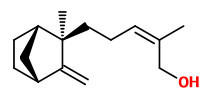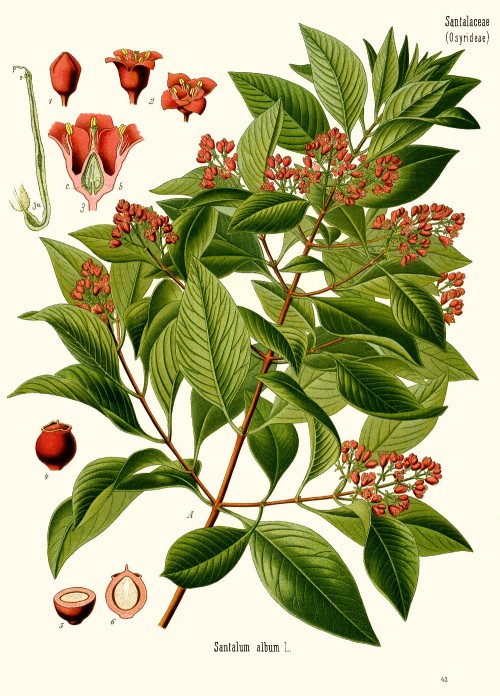Dies ist eine alte Version des Dokuments!
Santalum album L. - Santalaceae - (East Indian) sandalwood, white sandalwood, Sandelholz, (Indischer) Sandelholzbaum
Evergreen tree, native to Southeast Asia (India to Malesia) and Western Australia; leaves opposite, elliptic to ovate, glabrous above, glaucous benaeth; flowers small, reddish to purple-brown; fruit a fleshy drupe, globose, purple to black when ripe.
http://www.worldagroforestry.org/treedb2/AFTPDFS/Santalum_album.pdf
„S. album is a threatened species indigenous to South India, and grows in the Western Ghats and a few other mountain ranges such as the Kalrayan and Shevaroy Hills… Sandalwood from the Mysore region of Karnataka (formerly Mysore), and marayoor forest in Kerala, southern India, is high in quality. New plantations were created with international aid in Tamil Nadu for economic exploitation.“
https://en.wikipedia.org/wiki/Sandalwood
„S.album has been the primary source of sandalwood and the derived oil. These often hold an important place within the societies of its naturalised distribution range… The use of S. album in India is noted in literature for over two thousand years. It has use as wood and oil in religious practices.“
https://en.wikipedia.org/wiki/Santalum_album
„The analysis of odour components in East Indian Sandalwood Oil (Santalum album L.)… based on GC-, GC-FTIR- and GC-MS-data resulted in the identification of α-santalene, α-santalal, β-santalal, epi-β-santalal, α-santalol, β-santalol, (E)-β-santalol, α-bergamotol and spirosantalol in Sandalwood Oil… as the most intense aroma compounds of these oils.“
[GC-FTIR and GC-MS in odour analysis of essential oils., Nikiforov, A., Jirovetz, L., Buchbauer, G., Raverdino, V., Microchimica Acta, Vol.95(1-6), 1988, 193-198]
To identify the compounds evoking the characteristic aroma components of sandalwood oil, an aroma extract dilution analysis (AEDA) was applied. Among the nineteen aroma-active compounds detected by gas chromatography-olfactometry and AEDA in the flavor dilution (FD) factor range of 2-1024, α-santalene (FD 2) and β-santalene(FD 2) showed only low FD factors. (+)-(Z)-α-santalol (512) and (-)-(Z)-β-santalol (1024) showed the highest FD factors. Cyclosantalal (FD 32) and epi-cyclosantalal (FD 16) seem to be sensoric relevant (green-aldehydic, watery woody) components of sandalwood oil.
[Neue, geruchsaktive Inhaltsstoffe von sandelholzöl, teil 1. Isolierung und strukturaufklärung von cyclosantalal und epi-cyclosantalal., Brunke, E.J., Schmaus, G., Dragoco Report, 42, 1995, 197-217]
 (Z)-α-santalol (woody, cedarwood) |  (Z)-β-santalol (typical sandalwood, milky, urinous) |
„Wood of Santalum album and resin of Boswellia carterii Birdw. were used to obtain their volatile oils by means of supercritical fluid extraction with carbon dioxide… The main compounds contained in the sandalwood volatile oil were: α-santalol (46.1%), β-santalol (20.4%), epi-β-santalol (6.8%) and trans-α-bergamotol (5.4%). In the corresponding HD essential oil the α-santalol and β-santalol contents were lower: 35.0% and 14.0%, respectively.“
[Extraction of Santalum album and Boswellia carterii Birdw. volatile oil by supercritical carbon dioxide: influence of some process parameters., Marongiu, B., Piras, A., Porcedda, S., Tuveri, E., Flavour and fragrance journal, Vol.21(4), 2006, 718-724]
Analysis (GC-MS) of a steam-distilled dichlormethane extract of S.album wood from Kerala showed α-santalol (46-57%) and β-santalol (26-30%) as main components of the volatile oil. Other constituents were epi-cis-β-santalol (5-11%), (E)-α-bergamotol (2-4%), (E)-nuciferol (1-2%), teresantalol (1-2%) and (E)-β-santalol (1.0-1.4%), β-santalene (0.5-1.9%), (Z)-lanceol (0.4-1.5%), α-santalene (0.1-1%), epi-β-santalene (0.3-1.3%) and benzoquinone (0.1-0.4%).
[Identification of Santalum album and Osyris lanceolata through morphological and biochemical characteristics and molecular markers to check adulteration., Bhat, K.V., Balasundaran, M., Balagopalan, M., KFRI Res Rep. 307, 2006]
„The scent of the exquisite natural sandalwood oil is milky and creamy-lactonic, unlike any other wood, though a certain smoky dryness recalling cedarwood is also perceptible… (-)-(Z)-β-santalol, which accounts for 20-25% of the oils weight, is unanimously considered to be the main sandalwood vector…While (+)-(Z)-α-santalol and (+)-α-santalene have a rather weak odor, and are responsible for dry cedarwood facets, their metabolites and oxygenated derivatives of the normonoterpene santene contribute more to the typical odor character of sandalwood oil.“
Important trace components (ca.70 are known) of sandalwood oil are acetyldihydroalbene (woody-ambery with pronounced ionone aspects), N-furfurylpyrrole (roasty, pyrazine, herbaceous), dendrolasine (green, fatty, citrusy, nitrile-like), and (6R,7R)-α-bisabolol (strong floral, lily-of-the-valley); the structural related phenolics such as eugenol (clove), isoeugenol (carnation) and 6-methoxy eugenol (warm smoky) contribute with smoky aspects.
[Scent and Chemistry, Günther Ohloff, Wilhelm Pickenhagen, Philip Kraft, Wiley-VCH, 2012, 300-306]

Köhler, F.E., Medizinal Pflanzen, vol.3 t.43 (1890)
http://www.plantillustrations.org/species.php?id_species=905123
